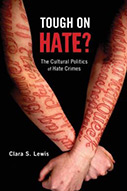Tough on Hate?: The Cultural Politics of Hate Crimes

Author: Clara S. Lewis
Publisher: New Brunswick, NJ; Rutgers University Press, 2013. 192p.
Reviewer: Brian Levin | January 2015
Clara S. Lewis’ Tough on Hate focuses a harsh analytic spotlight on the limitations of hate crime statutes, and the cultural politics relating to their institutionalization in the United States over recent decades. Though never meant to be the definitive book on hate crime, it is nonetheless rigorously researched and for the most part masterfully argued. Hate crime laws, primarily in the form of penalty enhancement statutes, punish the discriminatory selection of a crime’s target on the basis of characteristics such as race, religion and sexual orientation. Hate crime statutes, affirmed by the United States Supreme Court in 1993 in Wisconsin v. Mitchell, 508 U.S. 476 (1993), exist at the federal level and in over 45 states, though enforcement and data collection vary widely by jurisdiction.
Lewis, who teaches Writing and Rhetoric at Stanford University, makes an impressive, though at times, over extended case for a reconceptualization of hate crime. She envisions a broader context for the examination of hate crime, where other invidious, though less visible forms of systemic bigotry are recognized and addressed. Moreover, as a rhetoric instructor she brings a refreshingly concise, well researched and thoughtfully organized perspective on the limitations of these laws. She vigorously contends that the culture and language promoted by civil rights groups, the media and politicians forged a faulty narrative and urgency insufficient to conceptualize and remedy the overall damaging scourge of bigotry in America:
Can we hope to combat a problem that is hidden within its own publicity and whose defining features are in a constant state of political flux?…Even as the civil rights movement is tamed into textbooks and domesticated with grand monuments, we seem hard pressed to simply represent, not to mention respond to, the most important and least sensational civil rights issues of our time. Institutional, systemic, and everyday acts of anti-minority violence may be too subtle, too complex, too elusive and too potentially disruptive to attract the resources required to enter into mainstream visibility.
Lewis’ argument on the limited effectiveness of hate crime laws as a mechanism for resolving bigotry is a microcosm of the limitations seen, and often discussed, in criminal law generally. Many social deprivations, including drunk driving, homelessness, drug abuse, and domestic violence have an imperfect statutory response as well. Our criminal justice system is often a last resort and underequipped mechanism to respond to social ills whose causes run deeper and wider than the crimes manifested. Nonetheless, Lewis’ point that we need to “unmoor” or expand our recognition of what constitutes hate violence to more mundane, yet damaging acts, beyond sensationalized murders, is important, though not original.
Moreover, she makes a compelling point that hate crimes have been hypocritically and “symbolically cordoned off” as un-American within a culture still very much saddled with pervasive “ biases, prejudices and stereotypes that continue to divide American life.”
The “transformative political potential” for anti-hate crime efforts to lead to more sweeping remedies is lost when other forms of invidious bigotry are incorrectly assumed to be repositioned outside the fabric of everyday contemporary America, she maintains. Still, an incomplete fence like hate crime laws that protects half of the moral property of America by addressing violent manifestations of prejudice, is arguably better than none at all, and is probably transformative in its own right.
Kevin Boyle concluded in the New York Times Sunday Book Review that similar legislation, the Civil Rights of 1964, which inter alia, outlawed many forms of discrimination, was a “truly transformative” piece of legislation. This may also hold true for hate crime laws as well, notwithstanding its limitations, as Boyle explains: “The key sections [of the Civil Rights Act of 1964] outlawed the segregation of public spaces and prohibited employers and federal agencies from discriminating on the basis of race, sex or national origin. But the act’s significance extended far beyond its particulars, its purpose defined as much by morality as policy.” Lewis underplays the criminal law’s very potent normative effect distinct from deterrence, because at some elemental level it defines a society’s moral values. Furthermore, Lewis fails to meaningfully address how the confluence of various societal factors, such as increasing tolerance and grassroots advocacy, as well refinements in First Amendment jurisprudence, anti-discrimination legislation, and quality of life policing converged to propel hate crime legislation forward.
Part of Lewis’ analysis involves an extensive review of notorious hate crime murder cases. This is critically important for three reasons. First, murder, despite being the least common type of hate crime, and arguably the one most punished without sentence enhancers, is nonetheless the publicized constructed cultural maker of what hate crimes are. She argues, without explicitly labeling it as such, that the extensive focus on fatalities creates what economists call availability and unfamiliar event heuristics, where misperceptions and fears about the risk and frequency of events come to frame an inaccurate understanding of them and their context.
Members of historically marginalized groups are far more likely to suffer everyday routine deprivations that are not recognized or addressed due to the overarching concentration on fatal violence, she posits. Moreover, Lewis correctly points out that one of the primary ways that hate crimes were defined and marketed politically was part of an overall legislative effort to get tough on crime, that ironically, had a substantial negative impact on the very vulnerable communities that hate crime laws were supposed to protect. Furthermore, she contends, the sensationalizing of hate homicides had the corresponding effect of isolating the problem by class, relegating it to “white trash” or “blue collar” offenders, and thereby diverting attention away from the systemic bigotry which exists throughout all strata of society.
For Lewis, neo-liberals, crime control advocates, politicians, news media and others have all invented hate crime to a large extent. In doing so they connected it to past bigoted violence, a crime control narrative and a sensational moniker that not only defines hate crime too narrowly, but also distracts attention from non-sensationalized injustices such as disparate criminal sentencing between races, employment discrimination and voting rights deprivations. That criticism may be too sweeping in one respect, since physical hate violence is not merely an invented social construction. It is in fact a distinct, though arguably overpublicized problem relative to other more frequent and ignored deprivations. I would, however, go one step further on another point she does not address. The passage of hate crime legislation and data collection statutes has created a circumstance where many of these offenses are ignored because the passage of the laws, rather than their actual meaningful enforcement, is regarded as an end in itself. According to the Federal Bureau of Investigation, thousands of agencies do not participate in reporting programs and many that do, simply report zero hate crimes.
Lastly, she laudably discusses the role that literature and the arts can play with respect to combatting hate. This excellent point of “challenging hate crimes on a cultural front" could have been more fully explored. Widely distributed works such as the book and miniseries Roots, the play The Laramie Project, and the film Schindler’s List have advanced our societal sensibilities about prejudice and would be relevant in her epilogue about culture. Storytelling, she aptly points out, is a mechanism for understanding the feelings and experiences of others.
Though at times it overreaches, and almost resembles a literary historic political science analysis, Lewis’ book is relevant, thoughtful and very well argued. Tough on Hate is a highly valuable work that offers a perspective that compliments, advances, and at times challenges existing scholarship. Its greatest contribution is its critical central point: that combatting contemporary bigotry must be reassessed and expanded to include not only sensationalized violence, but other pervasive yet often ignored harms, that prejudice continues to inflict in our society.
Brian Levin is a Professor of Criminal Justice and Director of the Center for the Study of Hate & Extremism at California State University, San Bernardin
References
Wisconsin v. Mitchell
New York Times Book Review
Federal Bureau of Investigation


